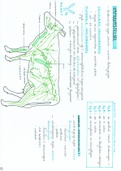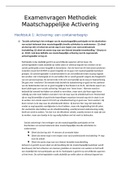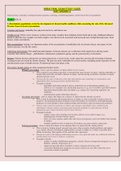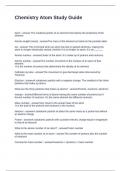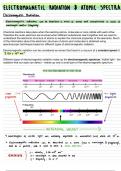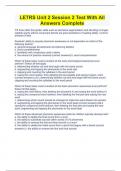Sex determination system
• Differs across species
• In humans, females (XX) are homogametic and males (XY) are heterogametic
• ZW system in birds and some fish
o Males are homogametic (ZZ), females heterogametic (ZW)
• Environmental sex determination
o E.g., temperature dependent
▪ Egg temperature
• 23-27C = mostly male
• 30C = female
▪ Hormone mediated
▪ E.g., spotted turtle
▪ Possible repercussions of global warming
• Infection dependant sex determination – Wolbachia spp
o Gram negative bacteria
o Intracellular bacterial parasites of orthropods and nematodes
o Transmission via egg (not sperm) so maternally inherited
o Wolbachia has ways to ensure survival by determining sex of offspring to be female (so can
be transmitted)
▪ Feminisation of gametes
▪ Parthenogenesis – spontaneous development of embryo from an unfertilised egg
cell
▪ Male killing – male do not survive in vivo
▪ Sperm-egg incompatibility
o Affects humans – e.g., elephantiasis, river blindness
o Hosts often require Wolbachia to survive – symbiosis
• Hermaphrodites
o Organisms with male and female gonads (reproductive organs)
o Frequent in invertebrates, occasional in vertebrates, usual in plants
o E.g., garden snail – simultaneous (has both organs)
o E.g., clownfish – sequential (can change sex)
▪ Microhabitat of sea anemone has 1 dominant male, if he dies next biggest clownfish
will change sex and become dominant male
Difference between gametes
• Gametes
o Specialised haploid cells produced by meiosis and involved in sexual reproduction
o Male gametes (spermatozoa) are small and motile
o Female gametes (oocytes) are larger and non-motile
o Gametes different in size, structure, and physiology
o Haploid – one set of chromosomes (n)
o Heterogamy – sexual reproduction involving fussing of ‘unlike’ gametes (fertilization)
Recombination
• Completely random shuffling of chromosomes to have a combination of genes from each parent in
gametes
• Genetic variation
• Avoids accumulation of detrimental mutations – ‘Muller’s rachet’
o Muller argued for the pros of sexual reproductive over asexual reproduction
o Asexual reproduction produces progeny genetically identical to parent resulting in an
accumulation of detrimental mutations over generations
, o Sexual reproduction produces progeny genetically different to parents, therefore reducing
mutation burden (recombination of mutation-free portions of parent’s genome) – it corrects
mutations in parent’s genomes
o Discussion arose with the question, ‘Why do so many organisms use sexual production to
produce offspring?’
▪ Asexual is easy, quick and guarantee offspring survival (as parent survived)
▪ Sexual reproduction introduces recombination so less likely to know if offspring will
have correct genome to survive
Is sex necessary?
• Parthenogenesis – clonal organisms
o E.g. Bdelloid rotifers – although also shown to have bacteria/fungi DNA from environment,
indicating genetic transfer has occurred to ensure survival
o Small, freshwater invertebrates have been asexual for 80 million years
• Horizontal gene transfer
Uniparental inheritance - Inheritance of mitochondrial DNA (mtDNA)
• A type on non-Mendelian inheritance – inheritance of traits that have a more complex genetic
basis than one gene with 2 alleles (1 from each parent) and complete dominance
• Unequal cytokinesis
• Disappearance of mtDNA
• Sperm organelle fails to enter egg
• Portioning into separate cells
• Exclusion of mitochondria from embryonic tissue
• Input bias
o The contribution of one gamete is much greater than the other
o Ovum has a large cytoplasm and hold 100,000 mitochondria
o Spermatozoan is much smaller and holds <100 mitochondria
• Selective destruction of mitochondria in gametes
o Mitochondria in sperm is selectively destroyed (selective silencing) and never even enters
egg
o Mechanism of paternal mtDNA differs across species
o In mammals, paternal mt are tagger with ubiquitin during spermatogenesis and degraded by
proteasomes and/or lysosomes are fertilisation
o In nematodes, paternal mt and membranous organelles engulfed by autophagosomes and
targeted for lysosomal degradation after fertilisation
o In fish, the number of mtDNA nucleoids decreases during spermatogenesis – after
fertilisation, paternal DNA further degraded before destruction of mitochondria structure
o In flies, paternal DNA degraded by EndoG during spermatogenesis
o In slime mould, mtDNA from 1 parent is selectively degraded in mitochondria after gamete
fusion
• mtDNA is usually maternally inherited
Biparental inheritance
• Inheritance of mtDNA from both parents
• Competition between mitochondria that are genetically different – produces smaller genome
(faster replication) but compromises ATP production
• Therefore, uniparental inheritance used
,BHCS3014 revision
‘Mitochondrial eve’
• Recently, mtDNA traced back to a woman living in sub-Saharan Africa – our most recent common
ancestor
• All living humans descended from her
• She lives approx. 200,000 years ago
Nuclear DNA (nDNA) must ‘match’ mtDNA
• There is an interaction between nuclear and mitochondrial genomes so the two must be
compatible
• e.g., electron transfer complex IV in OxPhos
o 13 polypeptides in mammals – 3 encoded by mtDNA, 10 encoded by nDNA
o Polypeptides must be compatible for enzyme to function
• Co-adaption required by both
o mtDNA mutation rate is much higher than nDNA
o nDNA shuffled by recombination
• Mismatches = decreased respiration efficiency = increases ROS
• Two sexes allow 1 set of nuclear genes to be tested against 1 set of mitochondrial genes
• Hypothesis is a better match leads to a longer lifespan
Dolly the sheep
• First ‘cloned’ animal – although not actually a clone as involved nuclear transfer
• DNA removed from oocyte (immature ovum, diploid) and transferred into somatic (differentiated)
cell
• Dolly has 2 mothers
o nDNA from donor of somatic cell DNA
o mtDNA from donor of oocyte
• somatic cell nuclear transfer has low success rate – Dolly – lived half of her life expectancy (died at
6 years old)
Summary
• Asymmetries in sex at higher levels of organisation
o e.g., differences between males and females, and associated behavioural traits
o may have their roots in the uniparental inheritance of mtDNA
• the reason for two sexes may lie in the need of co-adaption between nuclear and mitochondrial
genomes in order to maintain efficient ATP production via cellular respiration
Reproductive endocrinology
• Cholesterol is important for reproductive endocrinology – it is the basis for all steroids hormones
• The central endocrine centre is the hypothalamus
• The pituitary gland sits just underneath the hypothalamus, is pea-sized and is very important for
sex hormones
• Overview of areas and their hormones
o Hypothalamus
▪ Releases ‘controlling’ hormones, which cause the release of hormones from the
pituitary gland
▪ Thyrotrophin-releasing hormone (TRH)
▪ Growth hormone-releasing hormone (GHRH)
▪ Somatostatin
▪ Dopamine
▪ Vasopressin
, ▪ Oxytocin
▪ Gonadotrophin-releasing hormone (GnRH)
▪ Corticotrophin-releasing hormone (CRH)
o Pituitary gland
▪ More released from anterior (front) pituitary than posterior
▪ Posterior gland only releases 2 hormones
• Oxytocin
• Vasopressin (anti-diuretic hormone)
▪ Anterior pituitary
• Growth hormone
• Thyroid-stimulating hormone (TSH) (stimulated by TRH)
• Adrenocorticotrophic hormone
• Follicle-stimulating hormone (FSH) – stimulated by GnRH
• Luteinizing hormone (LH) – stimulated by GnRH
• Prolactin – for milk production and breast development
▪ Prions contaminate what is excreted by pituitary and cause prions disease (CJD –
Mad cow’s disease)
▪ FSH stimulate follicle to ovary causing ovulation
o Thyroid
▪ Used for basal metabolic rate
▪ Increase = hyperactivity
▪ Decease = fatigue
▪ Triiodothyronine (T3)
▪ Thyroxine (T2)
o Ovary
▪ Progesterone
▪ Estrogen
▪ Androstenedione
▪ Inhibin
o Testes
▪ Androgens
• Male effects
o Increase aggression
o Increase muscle mass
• Female effects
o Precursor to other hormones
o Causes acne (same in males)
o Growth of pubic hair
▪ Estradiol
▪ Inhibin
o Placenta (during pregnancy)
▪ Progesterone
▪ Estrogen
▪ Human chorionic gonadotrophin (hCG)
• Used for pregnancy tests (urine and blood)
• Found in blood before urine
• Blood more accurate
▪ Human placental lactogen
▪ Inhibin
o Uterus
▪ Prolactin

